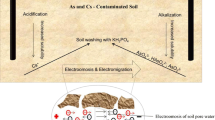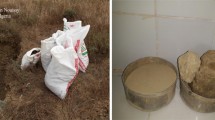Abstract
Electrokinetic remediation (EKR) is the most efficient technique for remediation of fine-grained soil. The primary removal mechanisms of heavy metal in EKR are the electromigration and electroosmosis flow under appropriate electric gradients. Most EKR studies have researched the variation according to the electrolyte and electric voltage. Also, EKR could be influenced by the migration velocity of ions, while few studies have investigated the effect of moisture content. In this study, soil moisture was controlled by using tap water and NaOH as electrolytes to enhance electromigration and electroosmosis flow. In both electrolytes, the higher moisture content led to the more As removal efficiency, but there were no differences between tap water and NaOH. Therefore, tap water was the most cost-effective electrolyte to remove As from fine-grained soil.






Similar content being viewed by others
References
Acar YB, Alshawabkeh AN (1993) Principles of electrokinetic remediation. Environ Sci Technol 27:2638–2647
Acar YB, Gale RJ, Alshawabkeh AN, Marks RE, Puppala S, Bricka M, Parker R (1995) Electrokinetic remediation: basics and technology status. J Hazard Mater 40:117–137
Alshawabkeh AN, Gale RJ, Ozsu-Acar E, Bricka RM (1999) Optimization of 2-D electrode configuration for electrokinetic remediation. J Soil Contam 8:617–635
Asadi A, Huat BB, Keykhah HA (2013) Theory of electroosmosis in soil. Int J Electrochem Sci 8:1016–1025
Baek K, Kim DH, Park SW, Ryu BG, Bajargal T, Yang JS (2009) Electrolyte conditioning-enhanced electrokinetic remediation of arsenic-contaminated mine tailing. J Hazard Mater 161:457–462
Ciblak A, Mao X, Padilla I, Vesper D, Alshawabkeh I, Alshawabkeh AN (2012) Electrode effects on temporal changes in electrolyte pH and redox potential for water treatment. J Environ Sci Health, Part A 47:718–726
Corwin D, Lesch S (2005) Apparent soil electrical conductivity measurements in agriculture. Comput Electron Agric 46:11–43
Helmholtz HV (1879) Studien über electrische Grenzschichten. Ann Phys 243:337–382
Huweg AFS (2013) Modelling of electrokinetic phenomena in soils. Doctoral Thesis, University of Southern Queensland
Jeon E-K, Ryu S-R, Baek K (2015) Application of solar-cells in the electrokinetic remediation of As-contaminated soil. Electrochim Acta 181:248–254
Jeon Y-S, Yang J-S, Park E-R, Yang J-W, Baek K (2016) Continuous electrochemical removal of salts from Korean food wastes. J Taiwan Inst Chem Eng 64:142–145
Kim S-O, Kim W-S, Kim K-W (2005) Evaluation of electrokinetic remediation of arsenic-contaminated soils. Environ Geochem Health 27:443–453
Kim EJ, Lee JC, Baek K (2015) Abiotic reductive extraction of arsenic from contaminated soils enhanced by complexation: arsenic extraction by reducing agents and combination of reducing and chelating agents. J Hazard Mater 283:454–461
Lee H-H, Yang J-W (2000) A new method to control electrolytes pH by circulation system in electrokinetic soil remediation. J Hazard Mater 77:227–240
Mitchell JK, Soga K (1976) Fundamentals of soil behavior. Wiley, New York
Park G-Y, Kim W-S, Kim D-H, Yang J-S, Baek K (2013) Evaluation of electrolyte and electrode spacing for application of electrokinetic remediation. J Soil Groundwater Environ 18:6–15
Reddy KR, Saichek RE, Maturi K, Ala P (2002) Effects of soil moisture and heavy metal concentrations on electrokinetic remediation. Indian Geotech J 32:258–288
Rhoades J, Manteghi N, Shouse P, Alves W (1989) Soil electrical conductivity and soil salinity: new formulations and calibrations. Soil Sci Soc Am J 53:433–439
Ryu B-G, Park G-Y, Yang J-W, Baek K (2011) Electrolyte conditioning for electrokinetic remediation of As, Cu, and Pb-contaminated soil. Sep Purif Technol 79:170–176
Ryu S-R, Jeon E-K, Baek K (2017) A combination of reducing and chelating agents for electrolyte conditioning in electrokinetic remediation of As-contaminated soil. J Taiwan Inst Chem Eng 70:252–259
Shin S-Y, Park S-M, Baek K (2016) Electrokinetic removal of As from soil washing residue. Water Air Soil Pollut 227:223
Virkutyte J, Sillanpää M, Latostenmaa P (2002) Electrokinetic soil remediation—critical overview. Sci Total Environ 289:97–121
Zhou DM, Deng CF, Alshawabkeh AN, Cang L (2005) Effects of catholyte conditioning on electrokinetic extraction of copper from mine tailings. Environ Int 31:885–890
Acknowledgements
This work was supported by KEITI through GAIA project (2016000550001) and partially funded by National Research Foundation of Korea (2015R1D1A1A09060537).
Author information
Authors and Affiliations
Corresponding author
Additional information
Responsible editor: Zhihong Xu
Su-Yeon Shin and Sang-Min Park contributed equally to this work.
Rights and permissions
About this article
Cite this article
Shin, SY., Park, SM. & Baek, K. Soil moisture could enhance electrokinetic remediation of arsenic-contaminated soil. Environ Sci Pollut Res 24, 9820–9825 (2017). https://doi.org/10.1007/s11356-017-8720-3
Received:
Accepted:
Published:
Issue Date:
DOI: https://doi.org/10.1007/s11356-017-8720-3




